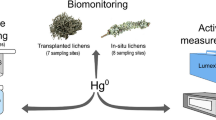Abstract
The concentrations of atmospheric gases and aerosols were measured using the four-stage filter-pack method to study the atmospheric chemistry and the representativeness of a site established near an expressway and a national road with heavy traffic in a coastal as well as an urbanized area. The clear seasonal difference in the concentrations of nitrate species (HNO3 and NO3 −) between the two sites was observed, and the difference was correlated with, but not quantitative, the atmospheric oxidation reaction from NO2 to HNO3. The concentrations of ammoniacal nitrogen (NH3 and NH4 +) were determined on a regional scale; in other words, their concentrations were not determined by specific emission sources, differently from the case of nitrate species. The temporal variation of the concentration of total sulfur (SO2 + SO4 2−) was largely controlled by the concentration of SO2, which, in turn, would be controlled by emission sources other than roads, differently from the cases of nitrate species and ammoniacal nitrogen. It was strongly suggested that there was an existence of the important sulfur emission sources: one candidate is sea traffic lane.













Similar content being viewed by others
References
Aikawa, M., Hiraki, T., & Tamaki, M. (2005). Characteristics in concentration of chemical species in ambient air based on three-year monitoring by filter pack method. Water, Air, and Soil Pollution, 161, 335–352.
Aikawa, M., Hiraki, T., Yamagami, M., Kitase, M., Nishikawa, Y., & Uno, I. (2008). Regionality and particularity of a survey site from the viewpoint of the SO2 and SO4 2− concentrations in ambient air in a 250 × 250-km region of Japan. Atmospheric Environment, 42, 1389–1398. doi:10.1016/j.atmosenv.2007.11.010.
Aikawa, M., Ohara, T., Hiraki, T., Oishi, O., Tsuji, A., Yamagami, M., Murano, K., & Mukai, H. (2010). Significant geographic gradients in particulate sulfate over Japan determined from multiple site measurements and a chemical transport model: Impacts of transboundary pollution from the Asian continent. Atmospheric Environment, 44, 381–391. doi:10.1016/j.atmosenv.2009.10.025.
Genfa, Z., Dasgupta, P. K., & Dong, S. (1989). Measurement of atmospheric ammonia. Environmental Science and Technology, 23, 1467–1474.
Japan Environmental Laboratories Association. (2008). Acid deposition survey in Japan, phase 4 (2006). Journal of Environmental Laboratories Association, 33(3), 2–72 (in Japanese).
Japan Meteorological Agency (2016). http://www.data.jma.go.jp/obd/stats/etrn/view/annually_s.php?prec_no=63&block_no=47770&year=&month=&day=&view= (last access 2016.6.18).
Kanaya, Y., Cao, R., Akimoto, H., Fukuda, M., Komazaki, Y., Yokouchi, Y., Koike, M., Tanimoto, H., Takegawa, N., & Kondo, Y. (2007). Urban photochemistry in central Tokyo: 1. Observed and modeled OH and OH2 radical concentrations during the winter and summer of 2004. Journal of Geophysical Research, 112, D21312. doi:10.1029/2007JD008670.
Kannari, A., Baba, T., Ueda, H., Tonooka, Y., & Matsuda, K. (2004). Development of a grid database on atmospheric pollutants emissions in Japan. Journal of Japan Society for Atmospheric Environment, 39(6), 257–271.
Karakas, D., & Tuncel, S. G. (1997). Optimization and field application of a filter pack system for the simultaneous sampling of atmospheric HNO3, NH3 and SO2. Atmospheric Environment, 31, 1657–1666.
Matsumoto, M., & Okita, T. (1998). Long term measurements of atmospheric gaseous and aerosol species using an annular denuder system in Nara, Japan. Atmospheric Environment, 32, 1419–1425.
Ministry of the Environment of Japan (2009). Comprehensive Summary Report on Acid Deposition Monitoring Survey (JFY2003-JFY2007) (in Japanese).
Misselbrook, T. H., Van Der Weerden, T. J., Pain, B. F., Jarvis, S. C., Chambers, B. J., Smith, K. A., Phillips, V. R., & Demmers, T. G. M. (2000). Ammonia emission factors for UK agriculture. Atmospheric Environment, 34, 871–880.
Murano, K., Hatakeyama, S., Mizoguchi, T., & Kuba, N. (1995). Gridded ammonia emission fluxes in Japan. Water, Air, and Soil Pollution, 85, 1915–1920.
Ren, X., Harder, H., Martines, M., Lesher, R. L., Oliger, A., Shirley, T., Adams, J., Simpas, J. B., & Brune, W. H. (2003). Ohx concentrations and OH reactivity observations in New York City during PMTACS-NY2001. Atmospheric Environment, 37, 3627–3637.
Sickles, J. E., II, Hodson, L. L., & Vorburger, L. M. (1999). Evaluation of the filter pack for long-duration sampling of ambient air. Atmospheric Environment, 33, 2187–2202.
Singh, H. B., Martines, J. R., Hendry, D. G., Haffe, R. J., & Hohnson, W. B. (1981). Assessment of the oxidant-forming potential of light saturated hydrocarbons in the atmosphere. Environmental Science and Technology, 15, 113–119.
Sutton, M. A., Dragosits, U., Tang, Y. S., & Fowler, D. (2000). Ammonia emissions from non-agricultural sources in the UK. Atmospheric Environment, 34, 855–869.
The Chemical Society of Japan (Ed.). (1990). KIKAN KAGAKU SOSETSU Chemistry of Atmosphere. Tokyo: Japan Scientific Societies Press. 103 pp (in Japanese).
Yokoyama, S., & Oshio, T. (2002). Estimated ammonia emissions from various sources in the basin of Lake Inbanuma. Annual report of Chiba Prefectural environmental research center, 2, 221–227 (in Japanese).
Yokoyama, S., Oshio, T., Hara, H. (2002). Emission of acidification chemical species in Chiba Prefecture (5) –Comparison of emission sources in urban area and rural area-. Proceedings of the 43rd Annual Meeting of the Japan Society for Atmospheric Environment, 398. (In Japanese).
Acknowledgments
The sampling at the Suma Aqualife Park in Kobe was conducted with the cooperation of the Suma Aqualife Park in Kobe.
Author information
Authors and Affiliations
Corresponding author
Rights and permissions
About this article
Cite this article
Aikawa, M., Morino, Y., Kajino, M. et al. Candidates to Provide a Specific Concentration Difference for Ambient Sulfur and Nitrogen Compounds Near the Coastal and Roadside Sites of Japan. Water Air Soil Pollut 227, 353 (2016). https://doi.org/10.1007/s11270-016-3069-7
Received:
Accepted:
Published:
DOI: https://doi.org/10.1007/s11270-016-3069-7




